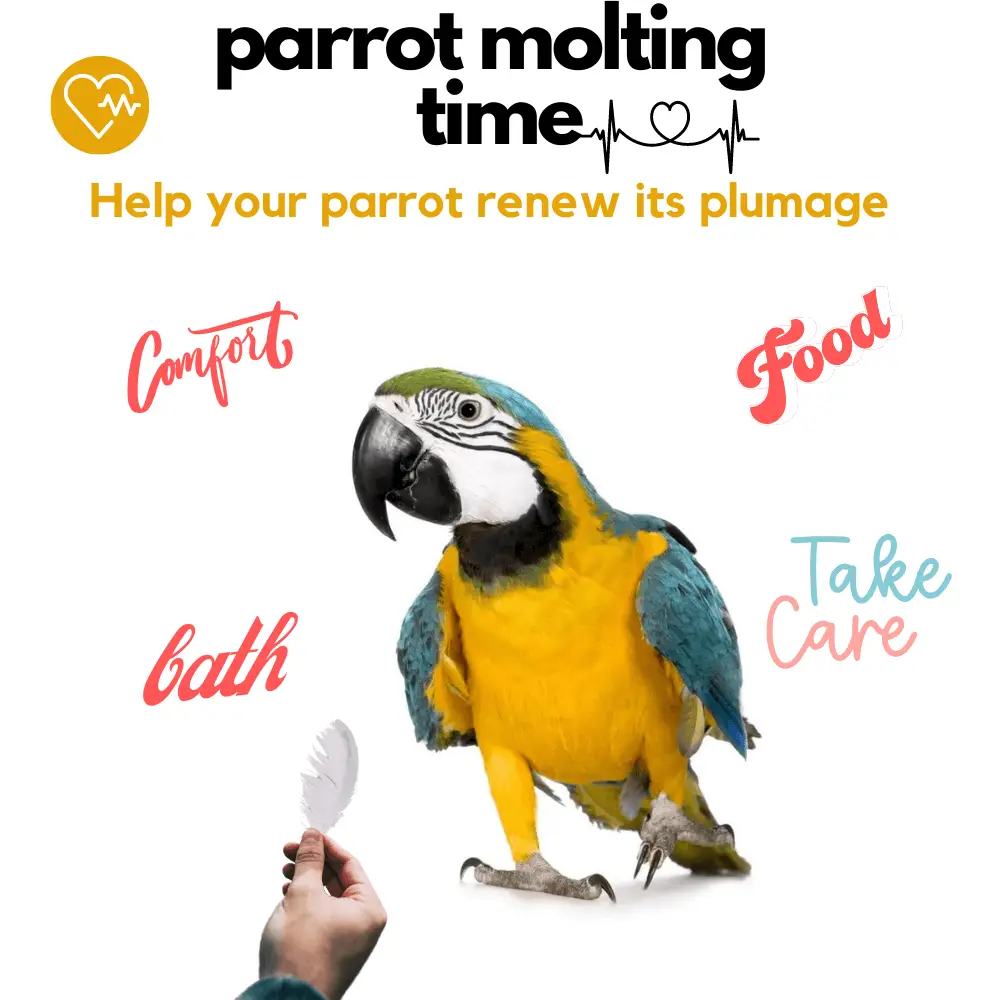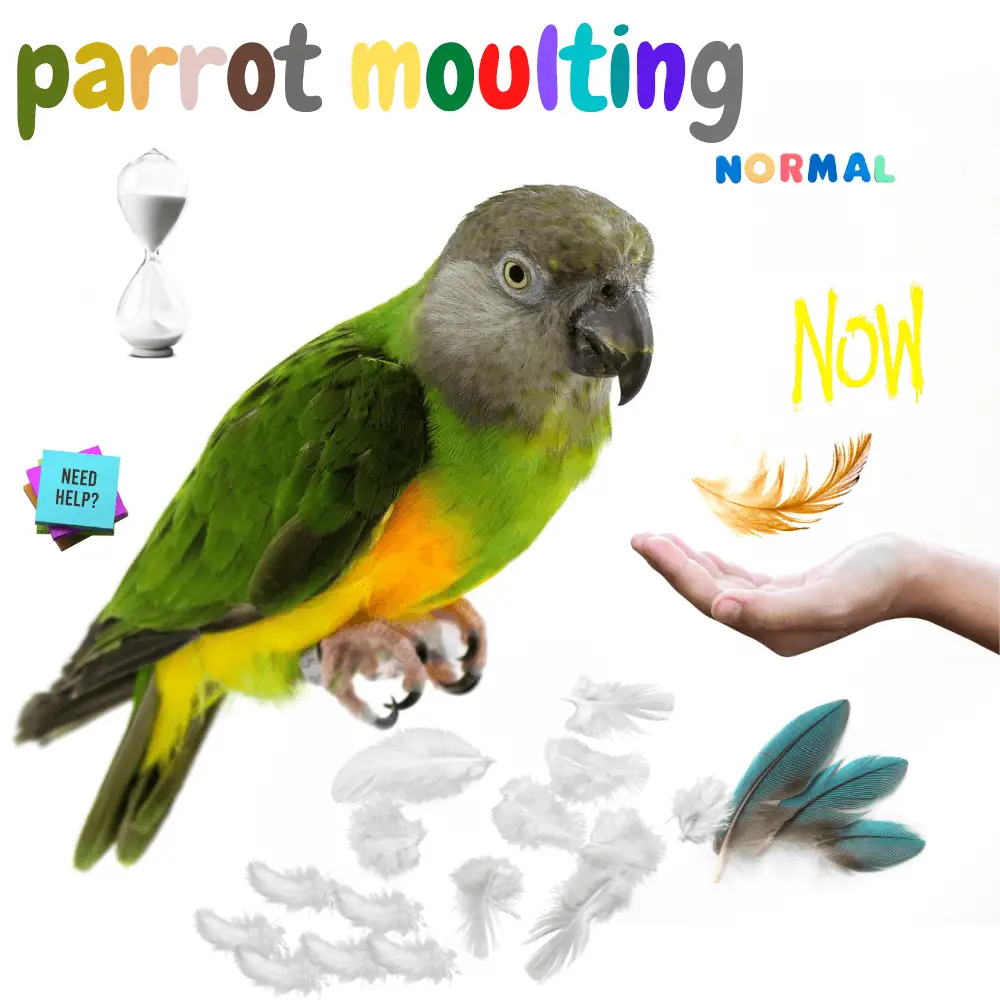Parrot molting refers to the renewal of plumage, which involves the loss of old feathers. During this period, which generally begins after the summer solstice, the Parrot has higher than normal energy needs, hence the need to provide it with more vitamins and minerals. Once a year, therefore, your Parrot will be moulting, and you will have to give it a little push to help it regain its silky plumage. We tell you all about it!
Parrot molting symptoms
What is moulting in birds? It is quite simply the renewal of the Parrots plumage which obviously involves the loss of the old feathers. Once a year, usually after the summer solstice, your bird will shed its old feathers to get brand-new plumage. The duration of moulting in Parrots varies depending on the species. The budgerigar, for example, lasts throughout the year, in more or less long sequences.
You probably know that beautiful plumage is a sign of a healthy and happy Parrot. Thus, like felines and other reptiles, Parrots begin their molt periodically, thus renewing their old plumage damaged by theft and their various activities.
Parrot molting time
During moulting, a bird loses all its plumage. You read that right: all its plumage! This requires considerable effort from the Parrot, so it is not uncommon for your bird to lose weight during its moult. Hence the importance of giving it a little nutritional boost because its energy needs increase during this crucial time of the year.
Your Parrot will particularly need more sulfur amino acids (basic composition of feathers), vitamins, and minerals. Thanks to these adapted nutritional contributions, the Parrot will be able to molt in optimal conditions, knowing that the diet also plays a role in the pigmentation of the plumage.
It is also necessary to ensure that the Parrot is in a calm environment with a stable temperature. Beyond the physical effort, the molt is emotionally very trying for the birds. Indeed, a molting Parrot is a stressed bird. The good news is that you can help her to better manage her molt. We tell you how!
Parrot molting behavior
How to help the Parrot during molting? Although the Parrot manages its molt alone in the wild, you can intervene to improve its comfort, especially if you notice that it loses a lot of weight during this period. And it all starts with good nutrition…

Parrot molting diet
As we told you, a molting parrot has higher nutritional needs than normal, because it will spend a lot more energy renewing its plumage. As you will have understood, it is very important to ensure the diet of the bird during this trying period.
Because the molting process draws directly on your bird’s reserves, it will be necessary to provide it with more vitamins to restore its strength, in particular vitamin D, and vitamin H, but also the proteins, which the parrot needs the help to synthesize collagen.
In addition to supporting your bird’s effort during molting, the vitamin intake will help it have silkier plumage and strong feathers. Ideally, start giving him some before the molting period. For this, we strongly recommend that you consult your veterinarian beforehand to have a precise idea of the appropriate dosages. And for maximum energy, you can opt for parrot worms, superfoods that are very high in protein.
Bathing parrot
parrots love to bathe, both to cool off during heat waves, to relieve their itching, and to get rid of the dirt that accumulates on their feathers. So remember to provide them with a small bathtub in the aviary, which will allow them to maintain their plumage.
It is also possible to add special products or bath salts to soften their feathers and prevent the formation of dandruff. This also allows their plumage to shine better, which is ideal during molting. Finally, be sure to wash your parrot regularly to make its skin more elastic and prevent the formation of cysts. In this way, its new plumage will form without great difficulty.
Ensure the comfort of the parrot
Remember that molting in parrots generally occurs after the summer solstice, a period often synonymous with heat. It is therefore essential to ensure that your parrot does not suffer too much from the consequences of summer (too much heat or exposure to the sun, not enough ventilation, etc.), by thinking for example of ventilating the room to improve its comfort. You should also know that the heat makes the parrots lose their appetite, whereas they need to eat more during the molting period to compensate for their higher energy expenditure.
Take care to put the molting parrot’s cage in a well-ventilated place, but without drafts, because it could get sick. Also, make sure that the cage is not exposed to direct sunlight and that the room is sufficiently illuminated. Ideally, install a thermostat in the room to keep an eye on the room temperature.
Parrot molting or plucking
If you have ever observed a moulting parrot, you will certainly have noticed that it scratches itself conspicuously and tears out the old feathers in order to facilitate the growth of new plumage. This is completely normal during molting. However, this behavior should not be confused with a fairly common behavioral disorder in birds, known as feather pecking. If you find that your parrot’s skin is bare in places, with self-harm lesions, it’s probably pecking. In this case, do not hesitate to consult your veterinarian.
In addition, it should be noted that feather loss can also be caused by phenomena other than molting. This is particularly the case when the parrot cage is installed in a room that is too hot or too bright. In such an environment, the parrot often loses its feathers. Hence the importance of ensuring that the bird’s environment is adapted to the needs of its species.
For example, a canary needs 8 to 10 hours of light exposure per day in summer, and slightly less in winter to stay healthy. Beyond 10 hours of exposure to light per day, the parrot is exposed to a risk of internal disturbance which results in the fall of the feathers.
SOURCE: Animal Wonders Montana
Read also:

